
You may have noticed (though, probably not) that I’ve been gone a while. While I was rotting away on a Soviet-era bunk in the middle of Hungary, my lack of connectivity haunted me for months. When I regained a reliable internet connection, I made two solemn vows: that I would avenge my brother’s death at the hand of “Slippery” Pete Samson, and that I would engage in some unrestrained retail therapy and piece together a gaming PC.
Well, I accomplished one of those things. As Ol’ Slippery Pete narrowly escaped my pursuit (turned out it’s not just a clever moniker), I found the two square feet of open air in Eastern Europe where I had cell service and started shopping. By the time I returned home, it had all arrived, bleaching in the Central Texas sun on my doorstep.
It houses a processor that can outrun the F-111 until takeoff (it can handle that much torque), the motherboard is the same one that runs all the Dwayne Johnson replicants (you think that’s one guy in all that stuff?), 16GB RAM (the fancy stuff that lights up all pretty so you know its fast), a GeForce GTX 1080 Ti video card the size of a refrigerator, and a 1TB SSD crafted out of metal from the meteor that destroyed Detroit. It’s all housed in a Trump brand mahogany casket filled with liquid nitrogen.

The price? 2700 bucks or something like that, including peripherals. Let’s put that in perspective. My dad’s first job in the insurance business in 1973 paid him $7700 a year. In today’s money, that’s about $38,000. My gaming rig, following the same iron-clad logic, would cost $14,885 dollars in today’s money.
I know what you must be thinking. “Wow. A $17,000 dollar PC? That’s impressive. I bet you can run absolutely anything on that. What are you going to review first? I am absolutely quivering with anticipation.”
What will be the first PC game I review with a $22,000 gaming rig?
Hard Time. $4.99 on Steam. System requirements: 2GB of RAM and a processor that will fog a mirror.
The first thing that crossed my mind when I first opened Hard Time was “Man. This game looks like hell.”
Well, that’s because it does.
It begins like many other games, with a character creator. You choose your name (please note that the difference between letter cases in your name merely decides the size of the capital letters). You choose your skin tone from a wide palette of alien shades, and you choose your hair from an unnecessary 145 styles. These hair styles come into play later, believe it or not. So, I made my character to look exactly like myself.
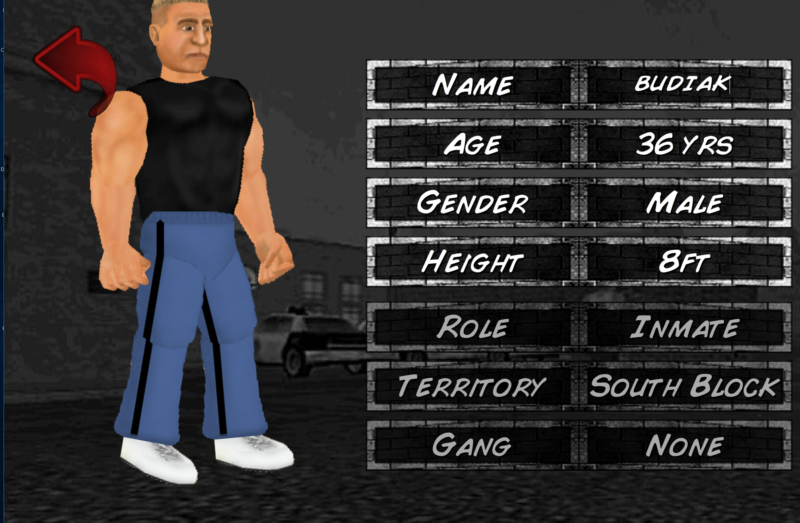
Amazing, right? 36 years old!
Once you are…ahem…satisfied… by the appearance and stats of your avatar, you are locked up and plunked right in the middle of the busy main hall of Southtown Penitentiary. Your crime? Thinking for yourself. From there, you have to battle a stream of inscrutable clues, unwieldy keyboard controls, and blackstrap-quick animation to try to make sense of it all. Get used to the courtroom scene. It will soon be your weekend home.
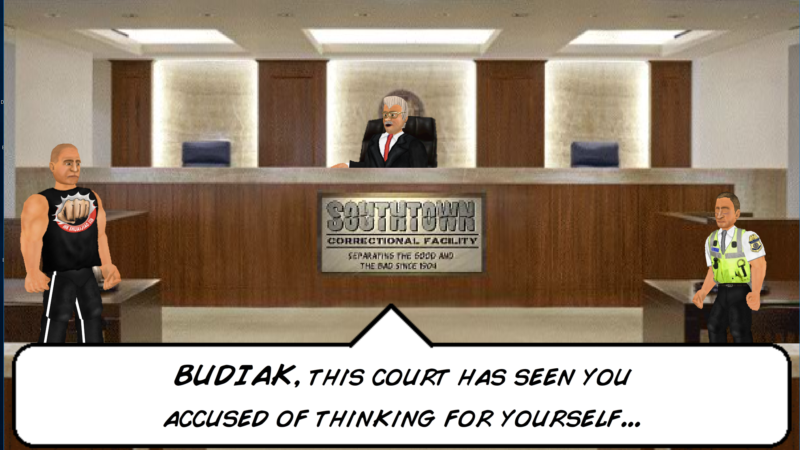
Once you are in lockup, you have precious little time to acclimate. You are immediately beset on all sides by psychopaths wielding pool cues, pool tables, vending machines, machine guns, lever-action rifles, microphones, crutches, beds, barbells, rolls of toilet paper, bananas, shovels, pipes, apples, garbage cans, and baseball bats that are all just lying around this teeming free-for-all of a maximum security prison.
Spend a little time running around aimlessly and you will eventually be handed a quest of sorts by one of your fellow inmates. Quests typically involve classic adventure goals such as finding someone, meeting a challenge in a duel, or bringing someone something that is lying right next to them. Like this quest given to me by the Incredible Hulk.
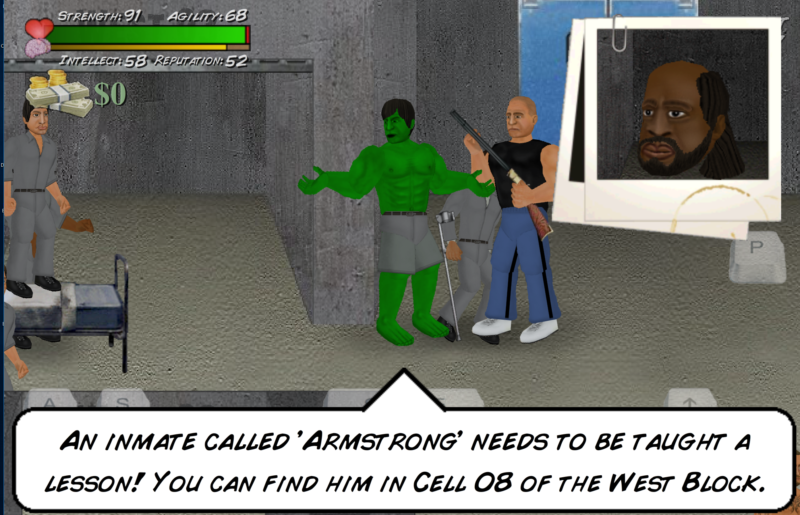
This is where one of the most frustrating things about Hard Time comes into play. Finding these people is far more difficult than it should be. In one particular quest, I was sent off to find someone in Cell 10, East Block. I immediately traveled to East Block to find nothing more than a Royal Rumble of comic book and movie characters, all rendered in brilliant low-res, Paint-esque 2D. The inmate’s only distinguishing feature was that he had a yellow mullet, which is not helpful when apparently 25 of the 145 hairstyles used to generate characters are derivations of the yellow mullet.
Instead of a ham-fisted tutorial, Hard Time takes a nuanced, sometimes insufficient, approach to revealing gameplay mechanics. Information is doled out in small bursts by friendly NPCs and by picking up ringing phones. The information is valuable, but the game ultimately suffers from the throttled flow of these tips, as it is heavily dependent upon your reputation (maybe), performance in quests (perhaps), or sheer dumb luck. At least you start each game with the keys mapped on the screen until you hit the “got it” icon on the top left.
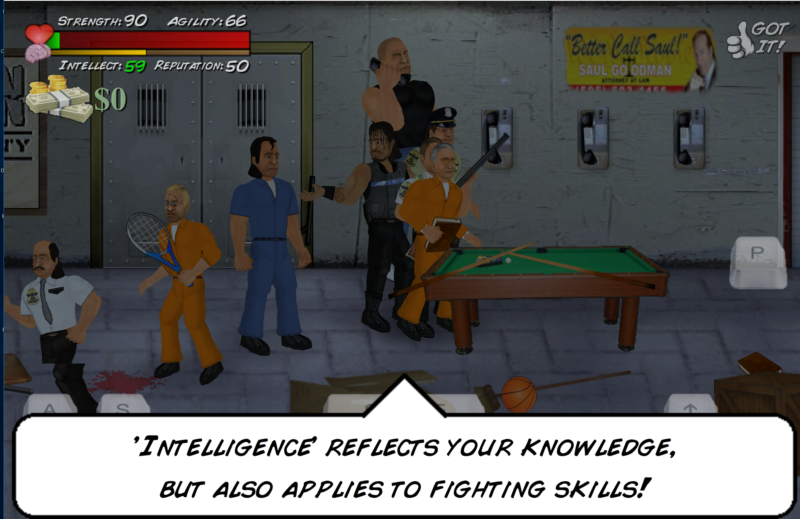
At the top of the screen, you can see a few attributes, the most important being reputation. If you have a low reputation, you will get jumped constantly, your fellow inmates will withhold information, and you won’t be able to join any gangs. A high reputation will get you respect, more information, and invitations to join nefarious ceremonies in the chapel. Gaining reputation is as easy as beating people to death (when no cops are watching), not crossing your friends, completing nebulous quests, or acting properly during interactions where there is no possible way to know how you should respond. It can also get you hugs.
Strength is how much punishment you deal, and how much of a beating you can take before you collapse into a crying heap and lose control of your character (a stress reaction that actually got my original Budiak character killed).
Intellect is affected by a confusing array of things. Pro tip: pounding someone who is laying on the ground seems to make you dumber, but does wonders for your reputation.
Agility…I still don’t really know what Agility does, because no NPC has randomly approached me to explain it, but I do know that taking a flying header off of a vending machine without a human target will lower it.
Once you get past its mechanics, it is hard to ignore the sheer…clunkiness of this one. Hard Time’s non-optimized graphics and engine absolutely brought my $32,000 PC to its knees. Get more than five inmates on one screen all scrapping about and blasting each other to pieces with dynamite and your system will slow to a crawl the same way your NES would plod painfully through a Legend of Zelda screen with too many River Zoras. Keep in mind the following evidence: a Battlefield 1 loading screen, proudly displaying a whopping 198 frames per second.

Yeah. I don’t think I need to tell you that it’s on “Ultra” settings. Given the evidence, I defy any potential accusation of digital prejudice to state that I should be able to effortlessly run a game that looks like Hard Time.
Now, this game is a port of a mobile game. That’s fine. I have reviewed plenty of games that started out on mobile platforms, the most notable being the excellent port of Punch Club.
This is where it gets interesting. See, this is not just a port of a mobile game. This is a game that was downloaded so much that it was featured in the Guinness World Records 2015 Gaming Edition.
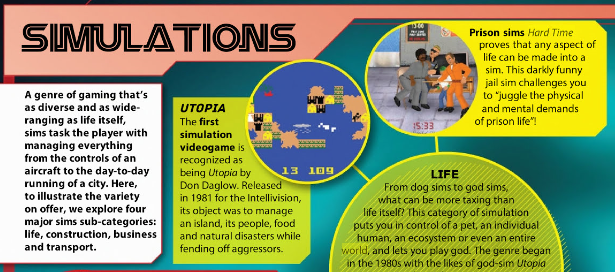
This sent me on a long and dramatic treasure hunt to learn more about this game, and about its creator. Why, God, is this game so popular? From my digging, I have found a few other salient morsels of information about this game and its predecessors.
See, Hard Time was created by a one-man operation named McDickie, who has been programming games since the 90s. If you consider his list of games, most of them are professional wrestling titles, the most famous being Wrestling Revolution 3D.

Look familiar?
Also, you absolutely must know that Wrestling Revolution and Hard Time, together, have over 700,000 five-star reviews on the Google Play store. Wrestling Revolution has over 40 million downloads. Forty million. Let’s compare that to a few things.
It’s more than the populations of Eastern Europe’s Black Sea states of Romania, Hungary, and Bulgaria combined (36,410,420).
It’s nearly 70 times the daily circulation of the New York Times. Seventy.
It’s 3.5 times as many miles of paved road there are in the world. Fun fact: a quarter of them are in the United States. I can attest to this fact, having recently blasted through a few gravel mountain roads in Romania that my Eastern European GPS thought perfectly acceptable for a Nissan Pulsar hatchback.
Now, coming off of what is an undeniable success, it makes sense to base all of your games off of a winning formula, which explains why it looks like Hard Time.
Actually, almost all of his games look exactly like Hard Time.
Like his coming of age tale School Days, which apparently tells the story of a young lad going to a preparatory school for professional wrestlers.

Or the industry simulator, Popscene, which puts you in charge of managing a band of professional wrestlers performing for what looks like a society comprised entirely of professional wrestlers.
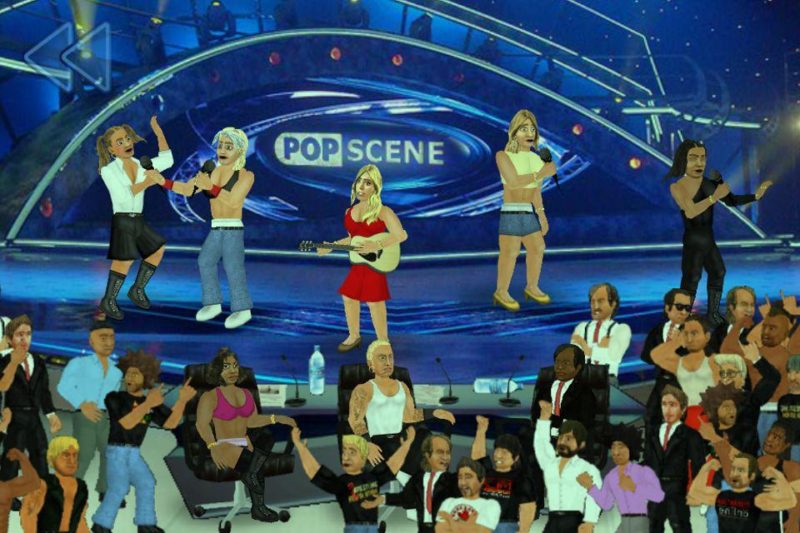
Or the deserted island survival opus, Wrecked, where you are on a professional wrestler superstar cruise and are shipwrecked on an island inhabited by an indigenous population of professional wrestlers.

All this, lovingly and faithfully tapped out over sleepless nights by a one-man programming shop…which makes Hard Time that much more difficult to review.
A good friend of mine once stated that art criticism required knowledge of a piece’s context, given the particular historical and cultural milieu, to achieve full understanding of its meaning. I’m pretty sure he said that during an argument about Blade Runner. Here, the context provides us with head-scratching incredulity rather than deeper understanding.
If we back away from the McDickie retrospective and take a hard look (get it?) at the game itself, there is much to be desired, despite hundreds of thousands of five-star reviews.
First and foremost, the controls are mushy, which is exacerbated by the sloth-like pace of the animations (slightly alleviated by increasing the game speed to 160% in the menu). Adding insult to injury, the 2D nature of the game leads to repeated mismatches of character planes, making any attack- other than the most methodically lined up punch- arduously difficult to land. There are four action buttons that are assigned to the A,S,Z, and X keys, which I found too close together for my comfort. Without the ability to re-map my keys, I found myself fat-fingering controls constantly, leading to dropped machine guns, picked up pool tables, and unintentionally punched prison guards.
Through four hours of play, I found the story elements of Hard Time elusive, to say the least. It is a free-roam, sandbox “prison simulator” of sorts, but its outdated interface and experiential learning curve hindered any real progress.
Let’s talk about the learning curve. Hard Time is incredibly difficult to play. Not in like a Contra sort of way. Hard Time is difficult as a byproduct of its design; the result of the nonsensical and unpredictable nature of the setting itself.
At your initial sentencing, you are given a number of days that you must serve. You could just sit in your cell and sleep for the full sentence, but where’s the fun in that? Well, in retrospect, that may be a far less painful experience than actually trying to play the game. If you step out of line (as everything in the game requires), you get beaten, shot, or arrested. Usually all three. The worst punishment is being arrested and having to go to court, because the punishment is always more time added to your sentence. The kicker is that at times it seems as if anything you do is going to get you arrested.
Loose your bowels? More time.

Judge Dredd catch you involved in a little cafeteria donnybrook? More time.
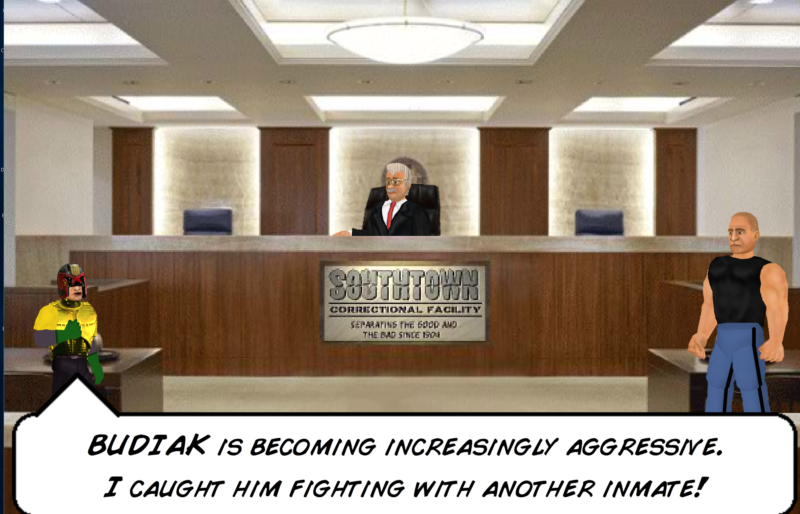
Swipe a machine gun in the spirit of self defense? More time.
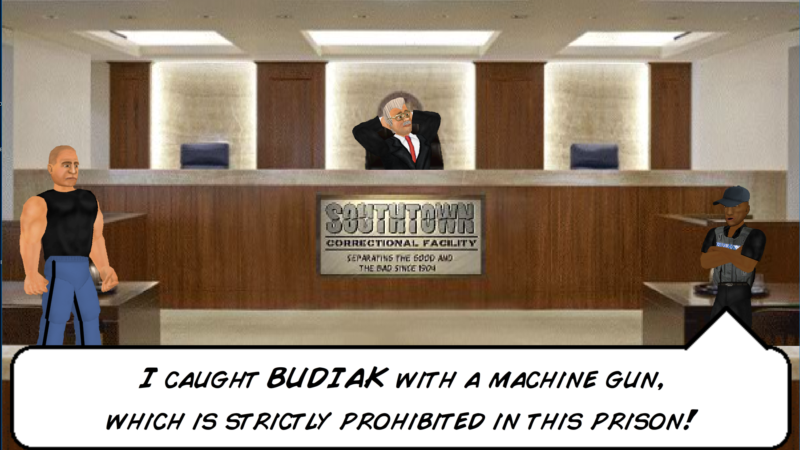
A warden challenged you to a duel to the death and you met his challenge with aplomb? More time.

It’s a game that gets in the way of itself. Not surprising seeing as it’s a ten year old wrestling game, set in a prison, that feels like it is still only half finished.
Don’t get it twisted, though. Amongst all of the arrests and quest-searching, there are numerous amusing moments to be enjoyed. While it is incredibly clunky and slow, the combat system is surprisingly complex, but I wouldn’t exactly call it robust. Landing a solid flying splash off of a folding table is quite satisfying, especially when you are rewarded by an increased attribute or your enemy conceding defeat as a result of your brutal onslaught. Engaging in a clandestine war on a rival gang, wiping them out with broomsticks and exploding fire extinguishers one by one, as you barely evade the wardens, is remarkably self-affirming. Not to mention the colorful cast of characters that occupy the prison. I mean, what other game can have you sleeping like a baby in the middle of the floor while Snake Plissken and The Incredible Hulk saunter past?

Sadly, the satisfaction is generally cut short by the limited scope and abundant technical shortfalls. For instance, the sound effects are a mishmash of home-studio quality recordings and snippets that seem cut from an off-track bootleg VHS copy of Commando. The story-telling elements are promising, but lack real depth where they could potentially offer a more compelling experience. All this is exacerbated by an inadequate control scheme and an options menu lacking basic choices. Surely, with 40 million downloads you could afford to improve the presentation and interface of your follow up game.
Despite its misgivings, I find it difficult to really slam this game as much as I want to…and I really, really want to. I made the fatal error of placing the game in context of the life of a man who is passionate about his craft- the McDickie fellow who has such a large and loyal following. Who has been pecking away at his keyboard for decades making computer games for the sheer love of his art. Unfortunately, I cannot review the man or his legacy. I have to review the game as it is before me.
RECOMMENDED (WITH CAVEAT)
Yes, there is a major caveat here, and it takes the form of a missed opportunity. What we have here is digital anachronism manifest. The artwork is highly dated. The controls make you question your life choices. What joviality it does provide is heavily affected by gameplay and combat mechanics that make you feel like you chugged a bottle of Benadryl. Your experience in the prison is a masterclass in learned helplessness.
Regardless of its glaring faults, there is a good amount of fun to be had with Hard Time. Beneath the rough exterior lies the potential for an excellent game. So much potential, in fact, that if this game were updated and improved into a more modern form, I am confident that it would be a major contender in the indie game market as more than a mere time suck. Hell, I more than doubled my required two-hour review gameplay for this game because once you get the hang of it, you begin to appreciate what McDickie is attempting. Unfortunately, around the same time that you have that revelation, Hard Time’s weaknesses begin to really rub. Still, for $4.99, it’s good for several hours of head-knocking and Hulk smashing. Not a bad way to exploit the power of a $52,000 gaming rig.
Now, if you’ll excuse me, I have a matter to attend to.

You’re damn right you don’t.

